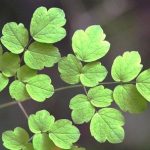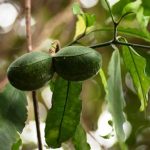TREE LIFE
November 1999
MASHONALAND CALENDAR
Tuesday 2 November. Botanic Garden Walk at 4.45 for 5 p.m. We will meet Tom in the car park and continue with the Euphorbiaceae family. There will be a guard for the cars.
Saturday 6 November. A Protea Atlassing workshop will take place at the home of Jim and Ann Sinclair. The workshop will be presented by staff from National Botanical Institute, Kirstenbosch who will demonstrate how the professionals tackle such a project. Starting time will be 9 a.m. Bring your tree book, some paper, a pencil and your picnic lunch and enjoy an interesting day with the fundis.
For more information about the visit which includes atlassing in Nyanga and Chimanimani please phone Maureen Silva-¬Jones during office hours.
Sunday 21 November. In 1988 we visited Lindy Riley on Galloway Farm near Norton (Remember Kim’s solo performance on the antics of the fig wasps)? This month we return to Galloway Farm but to the south side of the Bulawayo Road, and our hostess will be Margaret Riley. The venue is a shady, slightly rocky piece of woodland with a good selection of tree species. Bring a picnic lunch and meet at 9.30 a.m.
Saturday 27 November. Mark’s Walk is to the Holloway/Garnet property – 12 Welston Road where there may be some interesting monocots popping up at this time of year. Meet as usual at 2.30 p.m.
Sunday 5 December. Mr. Bill Clark is again kindly hosting our Christmas Social and Tree Bingo on his beautiful property in the Enterprise area.
Tuesday 7 December. Botanic Garden Walk.
MATABELELAND CALENDAR
Sunday 14 November. We will be joining the Protea Atlassing team from Cape Town. They will be showing us how to “atlas” Protea and we will be visiting various sites around Bulawayo. Please contact Anthon Ellert, Jonathan Timberlake or any committee member closer to the time for details of time and place.
Sunday 22 August ’99 – Burnside Farm.
As noted in Tree Life, Beverley and Roy Bishop are at the other end of Burnside Farm, where a previous visit revealed some unexpected species. Here the terrain changes from rocky areas to flat sandy soils with an interesting variety of species. The attractive farmhouse is situated close to the dam and tea served on the verandah was most welcome.
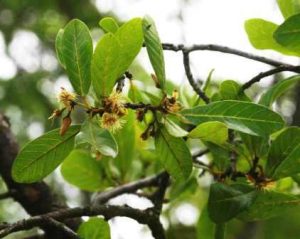
Monotes glaber. Photo: Bart Wursten. Source: Flora of Zimbabwe
Monotes glaber must be the commonest tree here with the little ‘helicopter’ fruits scattered far and wide. Another species although less common but with an interesting feature is Crossopteryx febrifuga, the crystal bark.
With a deft flick of his penknife, John Cottrill sheared away some old wood and these pieces when held towards the sunlight revealed the pattern of tiny pinpricks of shiny dots. There are the deposited silica crystals – a nightmare for wood-workers as tools become blunt very quickly. In other species common to us in Zimbabwe, the deposits of crystals act as a fire retardant and this led to an investigation by two researchers, to study the firewood potential of some indigenous and highly drought resistant tree species . The project covered Acacia karroo and Acacia tortilis as the pioneer species and Combretum apiculatum and Mopane as those often associated with secondary regrowth. The crystals found in the wood and bark a sample of these species were found to contain calcium oxalate, which initially produce oxygen when subjected to fire and then as the temperature of the fire increases the release of carbon dioxide retards flame size and the fire settles to a bed of glowing embers – the ideal braai fire. A further part of the project was to see if the idea of coppicing small trees was acceptable to rural communities to meet their firewood needs. In theory the project looked extremely promising, however, a nagging doubt exists – all the species noted above are not easily cut and frequently in marginal areas there is little vegetation to cut anyway. Regrettably, the paper did not state how effective the project had been or if the local people had responded positively to the trials. Perhaps Lyn Mullin or Jonathan Timberlake may have some further information on this project?
We must have spent considerable time chatting about the effects of crystals in the wood tissues for the remainder of the group appeared soon after with a good number of ticks on their Tree Cards. From here back through old lands with the ubiquitous Terminalia sericea and 3-4 meter regrowth of various Combretum. Shortly after admiring a magnificent Msasa in red foliage which must have escaped the axe when the lands were previously cleared, we came across the Linds at the next corner and found Anton Ellert fighting his way up and into an Acacia of some sort – possibly Acacia amythethophylla. Fortunately, the pair of environmentally friendly green overalls he was sporting kept the effects of prickles to a minimum, anyway whatever the species was Anton coped admirably with comments from the ground level.
The effects of a warm day took their toll and after lunch on the lush lawn overlooking the dam, some managed an afternoon stroll through the garden and its perimeter. Many thanks to Beverley and Roy for making it an enjoyable day in a picturesque place.
-Andy MacNaughtan
TRIP TO BAMBATA CAVE, MATOPOS, 5 SEPTEMBER 1999
After enjoying the delights of arboreal wanderings in West Virginia, USA in the month of July 1999, the time had come to return to Zimbabwe to be ready for the Extravaganza of Spring! This American adventure with the oaks, maples, ashes, walnuts, pines and hickories was quite enlightening. All of the hickory genus specimens, such as Shagbark, Sholebark, Pignut, Bitternut and Mockernut were examined and re-examined, the most prominent finding being bright yellow end buds in Bitternut (Carya cordiformis); these end buds were over half an inch long, and diagnostic for that species.
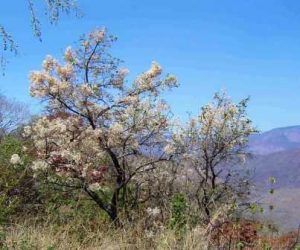
Dombeya rotundifolia. Photo: Bart Wursten. Source: Flora of Zimbabwe
On returning to Zimbabwe in early August, Wild Pear (Dombeya rotundifolia) was in flower attempting to correct the dullness of the veld. Even more so was the inflorescence of Pink Jacaranda (Stereospermum kunthianum) on Karna East Estate. On the last weekend of August, a trip to Karna for photography of this pink display was made, and many additional species were found. These included the red flower spikes of Knob thorn (Acacia nigrescens), followed by the white flowers giving the tree a spectacular view from a helicopter. Mass-flowering of Combretum collinum subsp. andongense, intermixed with old leaves, and the pink, red to green spring flush of Msasa (Brachystegia spiciformis) were spectacular along the road; this bright green colouring of Msasa is diagnostic. Another prominent showing was made by Combretum mossambicense; its common name of “shaving brush” is apt. We sought out many of these trees with their trailing branches. Not to be outdone was the Peeling-bark Ochna (Ochna pulchra) with its masses of flowers in terminal racemes. Late August and early September are the time to return to Zimbabwe for the extravaganza.
The Matabeleland Branch of the Tree Society, with two new members, met at Girl’s College and travelled to Bambata Cave in the Matopos. Acacia nigrescens and Acacia galpinii were seen prior to turning along a long bumpy road. After parking the vehicles, we entered into high yellow grass. Hearing noises on the road we bumped into a uniformed, armed guard stating that he was searching for a rhinoceros which had wandered into the area. To avoid any possible collision, we rapidly ascended the rocky area.
Almost immediately we encountered Erythroxylum emarginatum, still in leaf; the writer had never seen this tree-size, only as a shrub. An infrequently found tree was Brachylaena huillensis; closely followed by Brachylaena rotundata. Further on, we found Pappea capensis and Apodytes dimidiata. Olea europaea subsp. africana was found several times, but Strychnos matopensis was everywhere. An alert soul found Strychnos usambarensis with its narrowly tapering leaf apices. Before climbing rock, we had seen Maytenus senegalensis, Euclea divinorum and Euclea natalensis. The writer feels that Euclea racemosa was also encountered. Euphorbia ingens was spotted, and also Acokanthera, probably Acokanthera rotundata. The leaves were opposite and leathery, and we need to study this genus more carefully.
We climbed over rocks, under lianas, and slid down a huge granite boulder – with no loss of skin or trousers.
Many trees with missing leaves were encountered; the diagnosis of Grewia flavescens being made by the square branches and Commiphora marlothii using its bark. Terminalia sericea was identified by its curved branches and also by its fruit. Flacourtia indica leaves had turned a deep red colour, while Pseudolachnostylis maprouneifolia was determined by the shape and colour of its leaves. Pavetta eylesii was diagnosed by the bacterial nodules (although the leaf had to be straightened out from a dry, curled up state) and by its fruits. Some of these were collected for later planting. Tarchonanthus camphoratus leaves were also curled up and dry, but retained some of their fragrance; these leaves were larger than those previously seen by the writer. Rhus leptodictya was found, as were Catha edulis, Combretum molle and Elaeodendron matabelicum. Fig trees had retained their leaves; we saw Ficus natalensis and Ficus glumosa. Mimusops zeyheri retained its leaves, as did Tarenna zimbabwensis, while Pterocarpus rotundifolius was recognized by its winged fruit, and Lannea discolor was beginning to flower.
Other species noted were: Strychnos madagascariensis, Ziziphus mucronata, Ozoroa insignis, Homalium dentatum, Heteropyxis dehniae, Burkea africana and Dombeya rotundifolia.
Clem Van Vliet decided to give the writer a test and passed him two leaflets of a trifoliate leaf; the determination of Vepris reflexa given meant I passed! However, the leaves were taken home and the abundant gland dots noted under the microscope.
The meeting finished in the early afternoon with the thought that examination of the trees here should be done year-round. The writer feels that daily examination could be usefully made in the spring.
-Tom Raub
New concepts in Vangueria
The publication in 1998 of Volume 5(2) of Flora Zambesiaca brought with it some new concepts in the genus Vangueria. The purpose of this note is to set out the changes that are relevant to Zimbabwe.
Bob Drummond’s 1975 checklist, A List of trees, shrubs and woody climbers indigenous or naturalised in Rhodesia gives four species of Vangueria. These are as follows, together with the Flora Zambesiaca divisions in which they occur:
Vangueria apiculata NCES
Vangueria esculenta E
Vangueria infausta NWCES
Vangueria randii NWCES
These are reasonably familiar species to Tree Society members, although I personally do not know Vangueria esculenta. Vangueria infausta is of course a very common savannah species. Vangueria randii is very widespread but much more local and is more inclined to occur on anthills.
Vangueria apiculata is commonest in the E districts but spills westwards in areas of high rainfall (e.g. Makoni District) and in the outliers, e.g. Wedza Mountain. Vangueria esculenta is confined to the E Districts.
In the FZ account, there are three main points of interest.
The first one concerns Vangueria lasioclados. Bob Drummond included this as a synonym of Vangueria infausta. However, the FZ author, Diane Bridson has taken a different view and has elevated it to species rank as Vangueria proschii.
Andy, Maureen and I found this taxon a few years ago in hot dry Combretum woodland near Sanyati at an altitude of c.800 m. Bob Drummond identified it for me as Vangueria lasioclados and outlined the problem of whether it is distinct or not. It is clearly somewhat different from normal Vangueria infausta and some support for that might be found in the fact that we did not recognize it in the field.
It differs from Vangueria infausta in having longer hairs and having a tendency to dry a blue-black colour.
The second point of interest is the recognition of two subspecies of Vangueria infausta. The commoner appears to be subsp. infausta with leaves often immature at flowering time; the inflorescences not extensively branched, the corolla densely spreading hairy outside and with the lobes not apiculate.
The other is subsp. rotundata which is recorded in FZ only from the E division. Its features are: leaves mostly fully mature at flowering time, inflorescences often extensively branched, the corolla glabrous or spreading hairy outside and with lobes apiculate.
Thirdly, an additional species, Vangueria volkensii is recorded for E Zimbabwe. This is similar to Vangueria apiculata but differs in having hairy leaves and buds whereas in Vangueria apiculata these are glabrous.
-Mark Hyde
TREE SOCIETY OUTING TO MBAGAZEWA 20 SEPTEMBER 1999
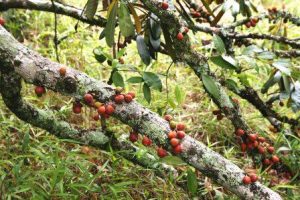
Englerophytum magalismontanum. Photo: Bart Wursten. Source: Flora of Zimbabwe
Mbagazewa is a very impressive granite outcrop with huge areas of open rock. It is a National Monument of considerable interest and we thank Rob Burrett for the brief introduction to the history of the area. Rob has written a book Shadows of our Ancestors for anyone interested in the history and it can be obtained from the Tree Society. ($50 only!)
Botanically, this is an interesting site too. At the base of the kopjie there was riverine type vegetation as a result of all the water that must pour off the rocks in the wet season. Species seen here included a with very velvety brown hairs underneath the leaves; Syzygium cordatum, the leaf with a sub-marginal vein and the base of the leaf hugging the stem; Tricalysia niamniamensis being Rubiaceae (opposite leaves with an interpetiolar stipule) and often with the flowers bunched together in threes; Rhus tenuinervis with typical trifoliolate leaves that are aromatic when crushed; Antidesma venosum, the tassel berry although we did not see any tassels. Rothmannia fischeri showed us its distinctive domatia in the axils of the lateral veins. To name just a few.
Notable in flower were Albizia tanganyicensis which was stark against the rocks with its peeling bark and puff ball flowers; Dalbergia nitidula was a mass of white pea like flowers with a strong sweet scent; Elephantorrhiza goetzei with maroon buds and some just opening to show the yellow flowers. Less spectacular flowers seen were Euphorbia matabelensis and Euclea natalensis. The seeds of Vernonia colorata were examined under a lens to see the small translucent glands that looked like tiny drops of water. These differ from Vernonia amygdalina which have hairs on them. In Meg’s key she also separates the two by flower colour. Vernonia amygdalina “flowers white” and Vernonia colorata “flowers with a mauve tinge”.
Euclea racemosa and Euclea divinorum were both seen. Euclea racemosa paler green with a much more rounded tip than Euclea divinorum. Euclea divinorum very definitely a diamond shaped leaf with a very wavy margin.
The energetic climbed up to the beacon where the view of the surrounding countryside is magnificent. In the afternoon another walk up the side of the kopjie revealed new species after new species. In total 77 species were recorded, a most enjoyable day!
-Sue duP.
For the ‘active’ group – we eventually made it up the steep slope of the massive granite base of Mbagazewa. Typical of most granites in the country, tiny depressions which form within the rock collect vegetation and these are colonised with tussocks of grasses, these particular ones being Coleochloa setifera, you need to be fit to remember this information on steep slopes! The woody vegetation in these pockets is generally one of the Xerophyta sp. and the stems are often blackened by fires. Half way up the slope the full view of Monks rock comes into sight and if you let your imagination run for a while the right hand part of the split rock gives the appearance of a huge brooding raptor.
Typical of the drier zones of Zimbabwe, the species which occur in this harsh environment are the three-forked Euphorbia, Euphorbia matabelensis, Sterculia quinqueloba where the faint vanilla-like scent of the resinous leaves was already wafting about and Mukwa, Pterocarpus angolensis, the seeds sometimes referred to as ‘hedgehog in a life ring’. Just below the beacon the boulders are really broken providing ideal habits for various species of owls and the unexpected sighting of a Barred Warbler. Mr. Edwards made an interesting point regarding their nesting habit in Muwanga – Pericopsis angolensis, the bird makes its nest by stitching leaves together.
A couple of the larger trees up here were massive specimens of possible hybrids of Brachystegia glaucescens x spiciformis (?) supporting features of both parents and also Erythrina latissima, the bark being smooth and slightly purple, whereas the common savannah resident Erythrina abyssinica has a corky bark. Any comment regarding these features?
To reach the beacon, ladders made of steel pipe and secured to the rock with lumps of concrete provide the way up and the view is incredible, except that on this particular day the haze limited clear vision to about 10km. While up here a strong breeze blew up and various hats escaped, Astri’s hat finding a resting place on a difficult to reach ledge just above a line of Heteropyxis dehniae, highly distinctive with their mottled bark. Bushman paintings seen were, unfortunately being slowly destroyed by the effects of a high dassie population.
A superb spot and well worth another visit. Grateful thanks to Dave and Sue for having recce’d the spot.
-Andy MacNaughtan
NYARUPINDA CATCHMENT
The Scene
Naturalists in Zimbabwe delight in the months August and September when all their five senses are used fully in observing all that is happening in our environment at the changing of the seasons. The following notes are from a diary.
July 31st 1999 was an exciting day, despite the noises of a motor rally in the Nyarupinda Valley the miombo woodland overlooked by Tinto house was alive at noon with the calls of Fish Eagles, two perched on a tree and another circling; coming head-on it dipped its wings as it called to the pair below, which stayed until mid-afternoon. Never before have we seen Fish Eagles so close to the garden, we watched spellbound, our vantage point the pool enclosure. The eagles were nearer to our pool than the dam.
August 26th 1999. A pair of Bennett’s Woodpeckers came to make their nesting hole facing a window of the house. They have chosen a weather-beaten stub of a main branch of Brachystegia boehmii. Their labour is flexi-time, neither male nor female works before 7.15 a.m. usually one begins between 10 a.m. – 12.30 p.m., they swap over and have left before 3 p.m. One to three days off has meant slow progress, sometimes the day’s work is only one hour. Their absences may lose them their hole to a Barbet. At present their chosen hole is protected by plenty of last season’s leaves, but these are likely to fall before the birds depart. To date 29 days have elapsed and incubation has not begun. They vocalize softly.
September 1st. The lonely Marula Sclerocarya birrea with its mysterious platform of poles has yielded plenty of fruit this winter, it must have hermaphrodite flowers, yet we read that there are male and female trees. Deep within the termitarium vegetation surrounding this tree, a farm worker has wedged a bag of several kilograms of fruit into the fork of the tree, to be collected under cover of darkness or used sparingly to attract game; two antelope had ambled ahead of us as we set out early in the morning to gather Marula for jelly and for fruit salad juice. Seeing the dog they leapt away, one looked back at us. Oribi are frequently seen near our homestead, duikers eat the introduced Carissa bushes and other shrubs planted outside the security fence.
Sept 4th. Half a fresh Snake Bean tree pod was the clue we followed which led to a memorable adventure. It began on the school children’s path bordering Katawa and Chinomwe in a cattle paddock in sandveld country, a likely environment for Swartzia to occur; many years ago solitary young trees were in this vicinity. Bush clumps were searched randomly moving away from the beaten track. We found the overgrown sunken silo, no longer protected with barbed wire, what lurked down there? A few paces away the huge circumference of a shed python skin and a solitary Snake Bean tree amazed us, at that moment my liege became tangled in discarded barbed wire, this would have delayed our retreat had the python been nearby. The Swartzia had been chopped; it lay along the ground but raised itself to make a canopy of leaves, no pods there or on the ground. In these circumstances some folk might have forgotten or been afraid to look for fruits, there must be another tree. Time to go home and measure the girth of the python, it was 52 cm; Mr. Fitz Simons, the herpetologist in South Africa states that their girth may reach 90 cm. As we approached the paddock gate we had sensed the fragrance of Carissa bushes which had yielded all the fruit needed for a year’s supply of jelly and enough scratches to last a lifetime. Emily Dibb wrote about the delights of Num Num in her book “The conundrum Tree” viz. p.74 & 75.
One route from ‘Tinto’ down to the Nyarupinda dam has recently been named Porcupine Path; it is about 100 m from the garden. Along it there are six heaps of scats and a signature of one quill to prove ‘who dunnit’. A Crossopteryx febrifuga. Crystal Bark further down the gentle slope had made a belated bunch of pink/orange honey-scented flowers at the end of February this year. This filled the gap left for flowers of this species in my annotated drawing book. This tree is often mutilated by the farm employees for a fever remedy and we are tempted to get a piece of freshly stripped bark to see glistening crystals on its inner surface.
In colonial times farmers burnt fireguards before leaving home to go to Salisbury to attend the Agricultural Show during the third week of August. These vistas of charred earth are the backdrop for sighting local fauna. Grass rejuvenates; almost instantly lowly brown and yellow orchids appear. Soon the suffrutex sub-shrub Combretum platypetalum oatesii tufts of red flowers are followed by “Red Wings” its four-winged fruits. Yellow Star and Bells of St Mary’s add yellow and blue to the landscape. In the distance there is Red Wing the moisture-loving prickly liana Pterolobium stellatum (seeming like a Bougainvillea) on termitaria and near watercourses. Common names stress the need for scientific names to distinguish each subject. Now that the ‘grass is down’ there is much more to see and on September 21st 1999 there was a very popular civet midden previously unnoticed a few steps east of Porcupine Path. At first glance it contained a clump of curled white feathers, it is interesting to investigate what these omnivorous Viverrines (not Felines) have devoured in addition to tree fruits and other seeds. This “new” civetry makes up (for me) for several disused ones within one kilometre of ‘Tinto’.
19th September 1999
This was when the Tree Society came to Ayrshire District to visit State Land, Mbagazewa kopjie. Here is a post script to the day’s ‘write-ups’.
“Uncle Bill” was helping his young relative with the scientific name for Mukwa, he jogged her memory about the silent p… she hesitated… yes Pterocarpus! Among the rocks… angolensis. There are numerous tree genera with silent P’s, you only have to refer to pp.945-947 in Trees of Southern Africa the 1977 edition, to count them. This would be an amusing question for a quiz, a score of 12 or above would be excellent. After lunch we saw two species of Monotes side by side, these were Monotes glaber (Monotonous labour) and Monotes engleri. The latter is a good birdwatchers’ tree, it is not densely leafy. On that day a twiggy full-grown tree called Pteleopsis anisoptera was observed and given special consideration because it is thought to be the link between the genera Combretum and Terminalia. It possesses intermediate features which can be checked in Kirkia the journal of the National Herbarium. This species of Pteleopsis, there is one other, is not often seen in our area in Brachystegia woodland, it occurs in Combretum/Commiphora thickets and Teak woodland along the northern border of Zimbabwe and in countries further north. This brings to mind that above mentioned genus Swartzia is intermediate between two subfamilies of Fabaceae (ex Leguminosae) namely Caesalpinioideae and Papilionoideae, something to follow up.
Charcoal and Charcoal Trees.
We are aware of charcoal when burnt toast pops up at breakfast time, between whiles the media has informed us that recently found prehistoric bones or equipment have been radiocarbon dated but now their age has been revised using modern technology. Later a braai is requested the fuel is ‘charbon de bois’ made from the hard wood of Wattle, Acacia mearnsii (Australian) trees grown in cultivated and renewable plantations in the Eastern Districts near Mutare. Our great-great grandparents may have eaten charcoal biscuits to absorb, more correctly in this case, adsorb alimentary gases resulting from the alfresco meal. ‘Sharpening the toast’ is what our son said when he watched the cook preparing breakfast on the “Dover” stove.
The ‘green’ newspaper Back to Basics featured “Mobile Charcoal Machine Makes Debut” – developed by Clun Valley Alder (Alnus sp.) Charcoal, Shropshire Hills Countryside Unit, Church Strelton, Shropshire. Alder wood was harvested to produce clog soles – this industry has declined and these trees have become too large and suckered too much and threaten the quality of riverside environments. Alders are made into charcoal for barbecue use. England imports 90% of its needs from ‘endangered mangrove’ swamps. Alder is better quality fuel but cannot compete price wise. This mobile furnace promotes long-term environmental gains.
In my childhood there were Forestry Commission plantations of Sweet Chestnut for pit props for the coat mines in East Kent, England. When exploring and gathering from hedgerows nearby, there were occasional clearing in the woods where conical arrangements of Sweet Chestnut branches too small for props steamed in the cool air. No one was about – never saw the charcoal burners – so the process was not explained to me at that time.
Charcoal has always been used for smelting iron and copper in Zimbabwe since just before the pre-Colonial Era ended, just over 100 years ago. There will be more on this topic which includes botany and chemurgy in the next letter.
Happy Treeing
-Benedicta Graves
SNIPPETS
A Fragrance Blooms in Space
A rose is a rose is a rose, but it is both more and less of a rose in the microgravity of space. Scientists sent a rosebud of the miniature variety “Overnight Sensation” into space with John Glenn and his fellow astronauts last year. They chemically sampled the rose as it opened. Analysis at International Flavours and Fragrances, a scent-development firm, showed that its overall aroma was only half as strong as that of an earthbound flower. But the highflier’s “floral rosy scent increased dramatically in space”, according to a researcher at IFF. The firm hopes that the rosy note will make a new fragrance sing.
(From the NATIONAL GEOGRAPHIC Magazine, July 1999)
The 1999 Msasa Flush
A visit to the Headlands region on 8 September found the Msasa at their most magnificent best. The trees were a bit past their best between Harare and Marondera, but all along the road from Marondera to Headlands their brilliant array of colours was superb. The previous day, 7 September, I was at Trelawney, but the Msasa there were definitely past their best.
-Lyn Mullin.
ANDY MACNAUGHTAN CHAIRMAN


